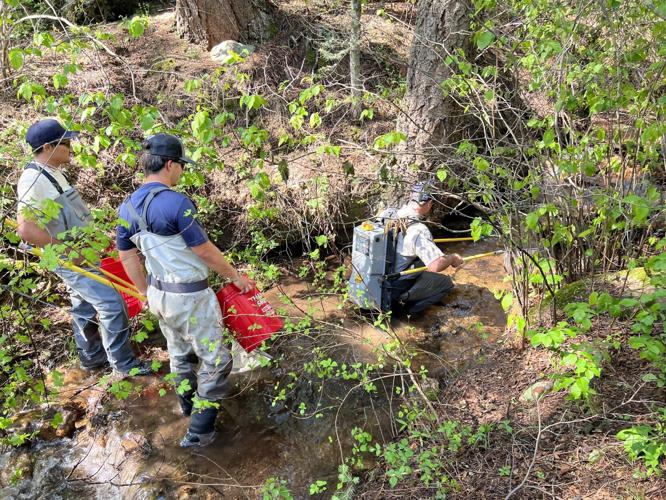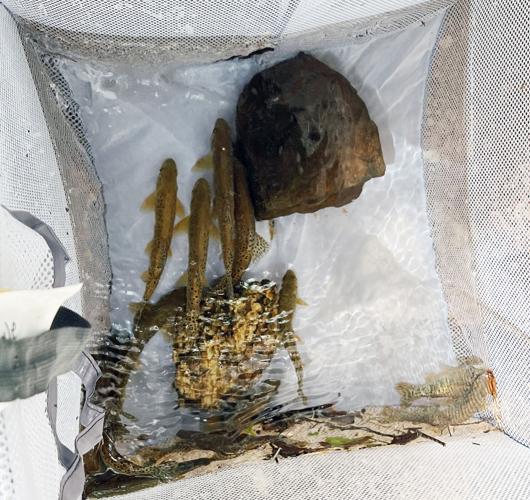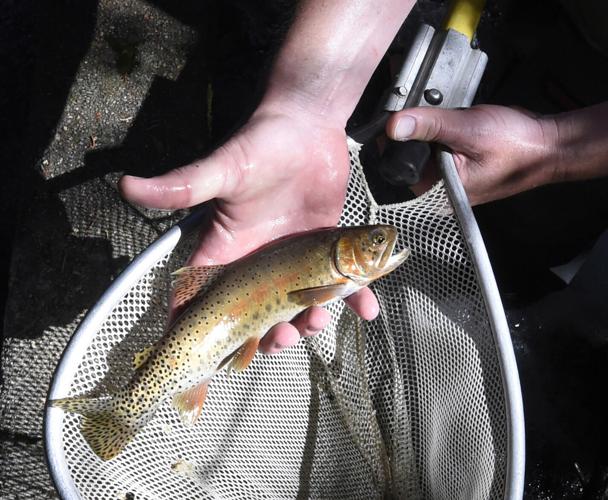‘Mixture of art, science and sport’ as CPW works to restore endangered trout population

Biologists from Colorado Parks & Wildlife shock the water of Bear Creek to make it easier to catch the Greenback Cutthroat Trout that live there. The biologists extract sperm and eggs from the fish, fertilize the egss, and then return them to the stream. Bear Creek near Colorado Springs is where the biologists were working on Tuesday, June 7, 2022. (Photo by Zach Dupont/The Gazette)
Colorado’s state fish, the greenback cutthroat trout, is under threat.
That’s why Colorado Parks and Wildlife (CPW) is spending time during the next two weeks to help try to expand the population of the trout in the state.
According to Cory Noble, an aquatic biologist with CPW, the population of the greenback cutthroat trout decreased from 2017 to 2020, the last time the CPW did a population survey for the fish.
“It is definitely concerning,” Noble remarked about the population decline. “It’s always concerning to see any decline.”
Colorado Springs artist teams up with police to create ‘biggest mural in city’
However, Noble said that it isn’t certain that the population of the trout is in decline. Noble said that, because CPW has only been doing intensive population studies for the trout since 2011, there isn’t enough data to make a firm conclusion.
Regardless, the greenback cutthroat is considered a threatened species, and was considered extinct at one point.
Noble said that, for a long time, Bear Creek was the only location where wild greenback cutthroat trout could be found in Colorado, and it’s believed that the trout were brought to the area unnaturally back in the late 1800s.
“As a matter of dumb luck, this ended up being the only surviving population of greenback cutthroat trout,” Noble said. “These have been linked genetically to the original fish from the 1800s.”
As part of the CPW’s ongoing work to reintroduce the fish to other areas of Colorado, a team of biologists went to Bear Creek just outside Colorado Springs on Tuesday to collect eggs and sperm from the trout.
Colorado Springs weather: Chance of thunderstorms remain throughout week
First, to collect the eggs and sperm the CPW has to actually catch the fish. To do this, biologists have to physically get in the creek and shock the water with what is called an electrofisher backpack. The electrofisher backpack gives off electric currents that initially attract the fish to the area before the electricity briefly stuns them.
On Tuesday, the CPW split into two teams of three to begin the first phase of the process. On each team, one member was tasked to use the electrofisher backpack and the other two to use nets and a bucket to catch the fish, a much more challenging task than it sounds.
“It’s a mixture of art, science and sport,” Noble said. “It takes some skill. … I’d like to think I’m good at it.”
“It’s like they’re goalies in a hockey game,” CPW press information officer Bill Vogrin said.
The teams got two hours to collect as many trout ready to produce eggs or sperm as possible, with trout that are considered spent — already produced recently — or green — not yet ready to produce — being put back in the creek.
Closing arguments heard in trial of man accused of killing father over inheritance money
The trout that are capable of producing eggs or sperm are placed into a bucket and brought up to the base camp on site where they are kept in a basket within in the creek.
In the two hours, CPW caught around 15 greenback cutthroat trout, only two of which were females.
The next step is for Noble to see how many eggs he can get from the females caught during earlier in the day and quickly fertilize them with sperm caught from the males.
Noble said that after the eggs leave the fish they go bad quickly, so teams have to fertilize the eggs on site to ensure the possibility of some eggs producing new trout.
On Tuesday, Noble said the two fish provided about 60 eggs that were fertilized by three different male fish also caught that day, which Noble said is done to help genetic diversity of the species.
However, Noble anticipates that less than half of those 60 eggs will result in a trout that is born and survives a full year.
“It would likely be less naturally,” Noble said when asked if the survivability of the eggs would be better or worse if left in the creek.
Colorado’s scenic, historic trains shine brightest in fall
The last step at the creek is for Noble to extract sperm from the remaining trout and store it. Noble said that the sperm collected on Tuesday from the male trout can be used to fertilize “thousands” of eggs.
After everything is collected — and the trout that were caught are re-released into the creek — CPW takes the samples to either the national fish hatchery located in Leadville, or CPW’s hatchery located in Salida.
“Using that (sperm and eggs obtained Tuesday) will improve the quality of our broodstock in the hatcheries,” Noble said. “And that broodstock is used to make fish that are used to restore the species out in the rest of the state.”
The need for the hatchery stems from the fact that the trout placed into new areas in Colorado have not yet started to reproduce naturally, something Noble stated he hopes to see start this year.
Tuesday was the first of two days in which CPW would be conducting spawning at Bear Creek for the greenback cutthroat trout, with the second session coming June 14.
Vogrin said that the spawning of the trout is a once a year occurrence for CPW because it is too invasive to perform several times over the year and could disturb the fish.
“It’s a stressful process on the fish,” Vogrin said.
Tuesday marked the first day in two years that CPW had conducted spawning at Bear Creek because it was skipped in 2021.
Overall, Noble considered Tuesday’s results as a big win.
“It went really well,” Noble said. “That will do a lot of good in the hatchery. … I’m really happy with that we got today.
And we get to do it all again next week.”
Get OutThere
Signup today for free and be the first to get notified on new updates.





